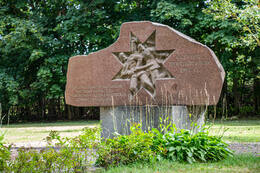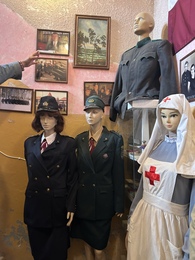The Great Cross-Border Route – Military Heritage of Latvia and Lithuania in 100 Years
Day 1.
90 km
Jelgava - Eleja - Jonišķi - Šauļi
Practical info
- Maršruts ir domāts kā padomdevējs - kā optimālāk apceļot reģionu vai valsti, vai divas valstis ar mērķi iepazīt to militāro mantojumu;
- Braucējam pašam ir jāizplāno – cik no ieteiktajiem objektiem un vietām viņš vienas dienas laikā var iepazīt;
- Pirms ceļojuma ir jānoskaidro apskates vietu (muzeju, kolekciju, fortifikācijas u.c. objektu) darba laiks;
- Vietās, kur ir iepriekšēja pieteikšanās (vietējie gidi, privātas kolekcijas, cits), ir jāpiesaka vizīte, norādot datumu un laiku. Ja ceļojums tiek atcelts, ir jāinformē pieteiktās vietas;
- Naktsmītnes ir jārezervē laicīgi. Vasaras sezonā, īpaši jūras piekrastē naktsmītnes var būt nepieejamas. Daļa no ēdināšanas uzņēmumiem ziemas sezonā var nestrādāt;
- Ceļojumam izvēlieties ne tikai vasaru, bet arī citus gadalaikus;
- Latvijas – Lietuvas – Igaunijas robežas pa autoceļiem var šķērsot brīvi bez ierobežojumiem un jebkurā diennakts laikā. Iebraucot no vienas valsts otrā ir jābūt līdzi ID kartei vai pasei;
- Apmeklējiet tūrisma informācijas centrus, kur var iegūt papildus informāciju, bukletus, kartes.
Sights
St. The tower of the Trinity Church in Jelgava, Akadēmijas Street 1, where Egon Užkurelis hoisted a homemade Latvian flag in 1952
In the tower of the St. Trinity Church in Jelgava, which was destroyed in the Soviet-German war in July-August 1944, on October 12, 1952, Egons Užkurelis, who was only 14 years old at the time, together with his friend Jānis Ģēģeris, who was a year older, hung a homemade Latvian national flag. This date was chosen because it was a Sunday when the Jelgava championship motorcycle racing took place in Pārlielupe, where many people gathered and from there the church tower could be clearly seen. The flag was made from a bed sheet, painted with watercolors. The way it was made later allowed the Chekists to guess that the flag-raisers should be sought among the students.
E. Užkurelis and J. Ģēģeri were arrested on October 23, 1952, followed by interrogation in Jelgava and at the Ministry of State Security of the Latvian SSR in Riga at the Corner House. The Criminal Court of the Riga Regional Court accused E. Užkurelis and J. Ģēģeri of anti-Soviet propaganda and agitation and participation in a counter-revolutionary organization. On January 10, 1953, E. Užkurelis was sentenced to five years in prison, and J. Ģēģeris to 15 years. E. Užkurelis was detained in Riga Central Prison for seven months until April 12, 1953, when he was released on the basis of an amnesty.
Jelgava History and Art Museum of Ģ. Eliass
Jelgava History and Art Museum of Ģ. Eliass is located in a building that is called Academia Petrina (Peter’s Acad emy). It was built in 1775 as the first university in Latvia and is one of the few public buildings in Jelgava to survive and be restored after World War II. In the summer of 1944, Jelgava lost almost everything – a large part of its popu lation and historic buildings, which were hardly restored after World War II. The predecessor of the current museum – the Kurzeme Provincial Museum – was founded in 1818. It was the second oldest museum in Latvia and the first one established outside Riga. The museum has been housed in the Academia Petrina building since 1952. Today, the museum features permanent exhibitions on the renowned Latvian artist Ģederts Eliass (1887–1975), the prehistory and Middle Ages of the Zemgale region, Jelgava during the era of the Duchy of Courland and Semigallia (1561–1795), the Courland Governorate (1795–1918), and the period of Latvia’s independence (1918–1940). The museum exhibition “Life Continues Under Foreign Rule” explores life in Latvia during the German and Soviet oc cupations. The virtual exhibition “Wars and a Soldier Through the Ages of Jelgava” offers insight into the various wars that have affected Jelgava, including historical events from the First and Second World Wars.
Monument to the Liberators of Jelgava “Lāčplēsis”
The Monument to the Liberators of Jelgava “Lāčplēsis” is located in Jelgava, at Station Park, opposite the Railway Station building. It was opened on 22 June 1932, with the participation of the Pre sident of Latvia A. Kviesis, and was built to commemorate the liberation of Jelgava on 21 November 1919, during the Latvian War of Independence. In 1940, during the first period of Soviet occupation, the monument was not affected by changes. In 1941, when the Soviet occupiers were replaced by the German occupation forces, the head of the German occupation administration, von Medem, who had retur ned to Jelgava (his ancestors were the original builders of Jelgava Palace), did not like the unequivocal symbolism of the monument. On 31 October 1942, the German occupation authorities ordered the author of the monument, Kārlis Jansons, to remove the image of a German knight from the monument. In 1950, the Soviet occupation authorities gave the order for the monument to be destroyed. With the help of a tractor, Lāčplēsis was torn off its pedestal, smashed, and an attempt was made to destroy it in a stone crusher. However, Lāčplēsis proved to be so hard that the crusher broke. The unbroken middle part of the monument was secretly buried in the grounds of a kindergarten. In 1988, a fragment of the monument was found and is now lo cated in front of the Jelgava History and Art Museum of Ģederts Eliass. The monument was restored and inaugurated on 21 No vember 1992. It was created by sculptor Andrejs Jansons, who restored the monument created by his father, K. Jansons.
Monument to the Defenders of Jelgava
The Monument to the Defenders of Jelgava – the Daugavgrīva Home Guards who stopped the German Army from attacking Jelgava at the end of April 1915, was unveiled in 1991 next to Svēte School in Jelgava Municipal ity. At the beginning of May 1915, a large demonstration was held in Jelgava to commemorate this important event. The fact that the Latvian Home Guards managed to stop the German attack was used by Jānis Čakste and his as sociates to justify the idea of establishing Latvian Riflemen units during World War I.
The author of the monument is sculptor Alīna Veibaha (1923–2011)
War Museum in Eleja
The museum is located in the former railway station build ing of Eleja Village. The War Museum in Eleja was established by the associa tion “Zemgales strēlnieks” (Zemgale Rifleman).
The rep resentatives of the association are active in public edu cation, putting on exhibitions, displays and educational programmes. The exhibition of the museum is mainly dedicated to World War II. It displays uniforms, equipment, armaments, and photographs of the historical period. The museum offers the opportunity to take photos in military uniforms of dif ferent historical periods and armies. The small two-storey building houses several hundreds of exhibits of military her itage. In addition, there are exhibits related to the town and surroundings of Eleja, the history of the region and its notable persons.
Joniškis Museum of History and Culture
Joniškis Museum of History and Culture was established in the centre of Joniškis in 1989. It features exhibitions reflecting the historical and archaeological treasures, ethnic culture and sacred art heritage of the region. Based on the initiative of historian Darius Vičas. The museum has an exhibition dedicated to the partisans of the Joniškis region. In a separate room, you are introduced to the personalities of partisans – fighters for Lithuanian freedom – and their struggle against the Soviet occupation. The exhibition features an authentic Olympia typewriter that served the last partisans of the Joniškis region, Kostas LiuberskisŽvainys and Steponas Erstikis-Patašonas. It was used to print issues of the partisan periodical “Partizanų šūvių aidas” (Echo of Partisan Shots). The underground newspaper was published from 1952 to 1957 in the territory of the Juozapavičius homeland (on the outskirts of Akmene, Joniškis, Žagarė and Kuršėnai districts). It is the last periodical published by partisans. The typewriter has been modified for interactive access to information – by pressing its keys, visitors see photos and hear stories about the partisan resistance. The radio receiver in
Places to eat
- Jelgavā, sk. visit.jelgava.lv
- Joniškis sk. visitjoniskis.lt
- Kafejnīca "Svētes klubs", Svētes pagasts
- Virtienių restoranėlis, Joniškis
- Šauļos, sk. visitsiauliai.lt
Places to stay
- Jelgavā, sk. visit.jelgava.lv
- Joniškis sk. visitjoniskis.lt
- Viesnīca “Senlīči”, Jaunvirslaukas pagasts, https://www.celotajs.lv/lv/e/senlici
- Viesnīca "Šiaurės Vartai", Joniškis
- Šauļos, sk. visitsiauliai.lt









